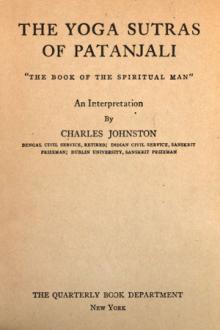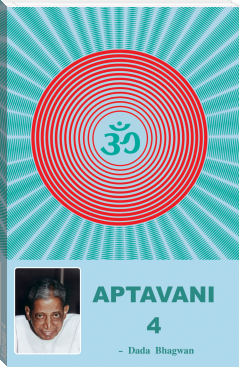The Yoga Sutras of Patanjali, Patañjali [most important books of all time TXT] 📗

- Author: Patañjali
- Performer: -
Book online «The Yoga Sutras of Patanjali, Patañjali [most important books of all time TXT] 📗». Author Patañjali
Fully to comment on this, would be to write a treatise on Karma and its practical working in detail, whereby the place and time of the next birth, its content and duration, are determined; and to do this the present commentator is in no wise fitted. But this much is clearly understood: that, through a kind of spiritual gravitation, the incarnating self is drawn to a home and life-circle which will give it scope and discipline; and its need of discipline is clearly conditioned by its character, its standing, its accomplishment.
14. These bear fruits of rejoicing, or of affliction, as they are sprung from holy or unholy works.
Since holiness is obedience to divine law, to the law of divine harmony, and obedience to harmony strengthens that harmony in the soul, which is the one true joy, therefore joy comes of holiness: comes, indeed, in no other way. And as unholiness is disobedience, and therefore discord, therefore unholiness makes for pain; and this twofold law is true, whether the cause take effect in this, or in a yet unmanifested birth.
15. To him who possesses discernment, all personal life is misery, because it ever waxes and wanes, is ever afflicted with restlessness, makes ever new dynamic impresses in the mind; and because all its activities war with each other.
The whole life of the psychic self is misery, because it ever waxes and wanes; because birth brings inevitable death; because there is no expectation without its shadow, fear. The life of the psychic self is misery, because it is afflicted with restlessness; so that he who has much, finds not satisfaction, but rather the whetted hunger for more. The fire is not quenched by pouring oil on it; so desire is not quenched by the satisfaction of desire. Again, the life of the psychic self is misery, because it makes ever new dynamic impresses in the mind; because a desire satisfied is but the seed from which springs the desire to find like satisfaction again. The appetite comes in eating, as the proverb says, and grows by what it feeds on. And the psychic self, torn with conflicting desires, is ever the house divided against itself, which must surely fall.
16. This pain is to be warded off, before it has come.
In other words, we cannot cure the pains of life by laying on them any balm. We must cut the root, absorption in the psychical self. So it is said, there is no cure for the misery of longing, but to fix the heart upon the eternal.
17. The cause of what is to be warded off, is the absorption of the Seer in things seen.
Here again we have the fundamental idea of the Sankhya, which is the intellectual counterpart of the Yoga system. The cause of what is to be warded off, the root of misery, is the absorption of consciousness in the psychical man and the things which beguile the psychical man. The cure is liberation.
18. Things seen have as their property manifestation, action, inertia. They form the basis of the elements and the sense-powers. They make for experience and for liberation.
Here is a whole philosophy of life. Things seen, the total of the phenomena, possess as their property, manifestation, action, inertia: the qualities of force and matter in combination. These, in their grosser form, make the material world; in their finer, more subjective form, they make the psychical world, the world of sense-impressions and mind-images. And through this totality of the phenomenal, the soul gains experience, and is prepared for liberation. In other words, the whole outer world exists for the purposes of the soul, and finds in this its true reason for being.
19. The grades or layers of the Three Potencies are the defined, the undefined, that with distinctive mark, that without distinctive mark.
Or, as we might say, there are two strata of the physical, and two strata of the psychical realms. In each, there is the side of form, and the side of force. The form side of the physical is here called the defined. The force side of the physical is the undefined, that which has no boundaries. So in the psychical; there is the form side; that with distinctive marks, such as the characteristic features of mind-images; and there is the force side, without distinctive marks, such as the forces of desire or fear, which may flow now to this mind-image, now to that.
20. The Seer is pure vision. Though pure, he looks out through the vesture of the mind.
The Seer, as always, is the spiritual man whose deepest consciousness is pure vision, the pure life of the eternal. But the spiritual man, as yet unseeing in his proper person, looks out on the world through the eyes of the psychical man, by whom he is enfolded and enmeshed. The task is, to set this prisoner free, to clear the dust of ages from this buried temple.
21. The very essence of things seen is, that they exist for the Seer.
The things of outer life, not only material things, but the psychic man also, exist in very deed for the purposes of the Seer, the Soul, the spiritual man Disaster comes, when the psychical man sets up, so to speak, on his own account, trying to live for himself alone, and taking material things to solace his loneliness.
22. Though fallen away from him who has reached the goal, things seen have not alto fallen away, since they still exist for others.
When one of us conquers hate, hate does not thereby cease out of the world, since others still hate and suffer hatred. So with other delusions, which hold us in bondage to material things, and through which we look at all material things. When the coloured veil of illusion is gone, the world which we saw through it is also gone, for now we see life as it is, in the white radiance of eternity. But for others the coloured veil remains, and therefore the world thus coloured by it remains for them, and will remain till they, too, conquer delusion.
23. The association of the Seer with things seen is the cause of the realizing of the nature of things seen, and also of the realizing of the nature of the Seer.
Life is educative. All life’s infinite variety is for discipline, for the development of the soul. So passing through many lives, the Soul learns the secrets of the world, the august laws that are written in the form of the snow-crystal or the majestic order of the stars. Yet all these laws are but reflections, but projections outward, of the laws of the soul; therefore in learning these, the soul learns to know itself. All life is but the mirror wherein the Soul learns to know its own face.
24. The cause of this association is the darkness of unwisdom.
The darkness of unwisdom is the absorption of consciousness in the personal life, and in the things seen by the personal life. This is the fall, through which comes experience, the learning of the lessons of life. When they are learned, the day of redemption is at hand.
25. The bringing of this association to an end, by bringing the darkness of unwisdom to an end, is the great liberation; this is the Seer’s attainment of his own pure being.
When the spiritual man has, through the psychical, learned all life’s lessons, the time has come for him to put off the veil and disguise of the psychical and to stand revealed a King, in the house of the Father. So shall he enter into his kingdom, and go no more out.
26. A discerning which is carried on without wavering is the means of liberation.
Here we come close to the pure Vedanta, with its discernment between the eternal and the temporal. St. Paul, following after Philo and Plato, lays down the same fundamental principle: the things seen are temporal, the things unseen are eternal.
Patanjali means something more than an intellectual assent, though this too is vital. He has in view a constant discriminating in act as well as thought; of the two ways which present themselves for every deed or choice, always to choose the higher way, that which makes for the things eternal: honesty rather than roguery, courage and not cowardice, the things of another rather than one’s own, sacrifice and not indulgence. This true discernment, carried out constantly, makes for liberation.
27. His illuminations is sevenfold, rising In successive stages.
Patanjali’s text does not tell us what the seven stages of this illumination are. The commentator thus describes them:
First, the danger to be escaped is recognized; it need not be recognized a second time. Second, the causes of the danger to be escaped are worn away; they need not be worn away a second time. Third, the way of escape is clearly perceived, by the contemplation which checks psychic perturbation. Fourth, the means of escape, clear discernment, has been developed. This is the fourfold release belonging to insight. The final release from the psychic is threefold: As fifth of the seven degrees, the dominance of its thinking is ended; as sixth, its potencies, like rocks from a precipice, fall of themselves; once dissolved, they do not grow again. Then, as seventh, freed from these potencies, the spiritual man stands forth in his own nature as purity and light. Happy is the spiritual man who beholds this sevenfold illumination in its ascending stages.
28. From steadfastly following after the means of Yoga, until impurity is worn away, there comes the illumination of thought up to full discernment.
Here, we enter on the more detailed practical teaching of Patanjali, with its sound and luminous good sense. And when we come to detail the means of Yoga, we may well be astonished at their simplicity. There is little in them that is mysterious. They are very familiar. The essence of the matter lies in carrying them out.
29. The eight means of Yoga are: the Commandments, the Rules, right Poise, right Control of the life-force, Withdrawal, Attention, Meditation, Contemplation.
These eight means are to be followed in their order, in the sense which will immediately be made clear. We can get a ready understanding of the first two by comparing them with the Commandments which must be obeyed by all good citizens, and the Rules which are laid on the members of religious orders. Until one has fulfilled the first, it is futile to concern oneself with the second. And so with all the means of Yoga. They must be taken in their order.
30. The Commandments are these: nom injury, truthfulness, abstaining from stealing, from impurity, from covetousness.
These five precepts are almost exactly the same as the Buddhist Commandments: not to kill, not to steal, not to be guilty of incontinence, not to drink intoxicants, to speak the truth. Almost identical is St. Paul’s list: Thou shalt not commit adultery, thou shalt not kill, thou shalt not steal, thou shalt not covet. And in the same spirit is the answer made to the young map having great possessions, who asked, What shall I do to be saved? and received the reply: Keep the Commandments.
This broad, general training, which forms and develops human character, must be accomplished to a very considerable degree, before there can be much hope of success in the further stages of spiritual life. First the psychical, and then the spiritual. First the man, then the angel. On this broad, humane and wise foundation does the system of Patanjali rest.
31. The Commandments, not limited to any race, place, time or occasion, universal, are the great obligation.
The Commandments form the broad general training of humanity. Each one of them rests on a universal,





Comments (0)